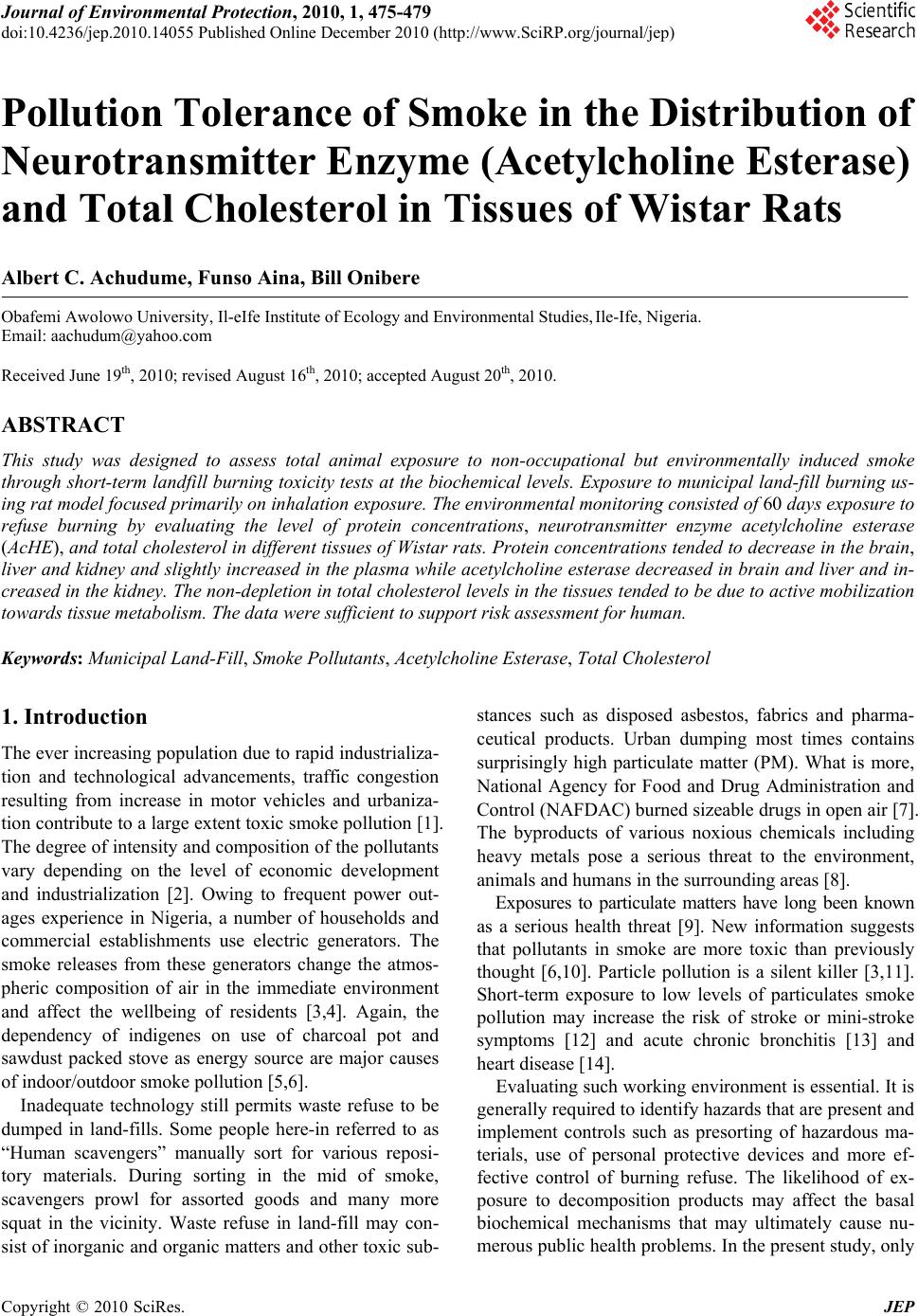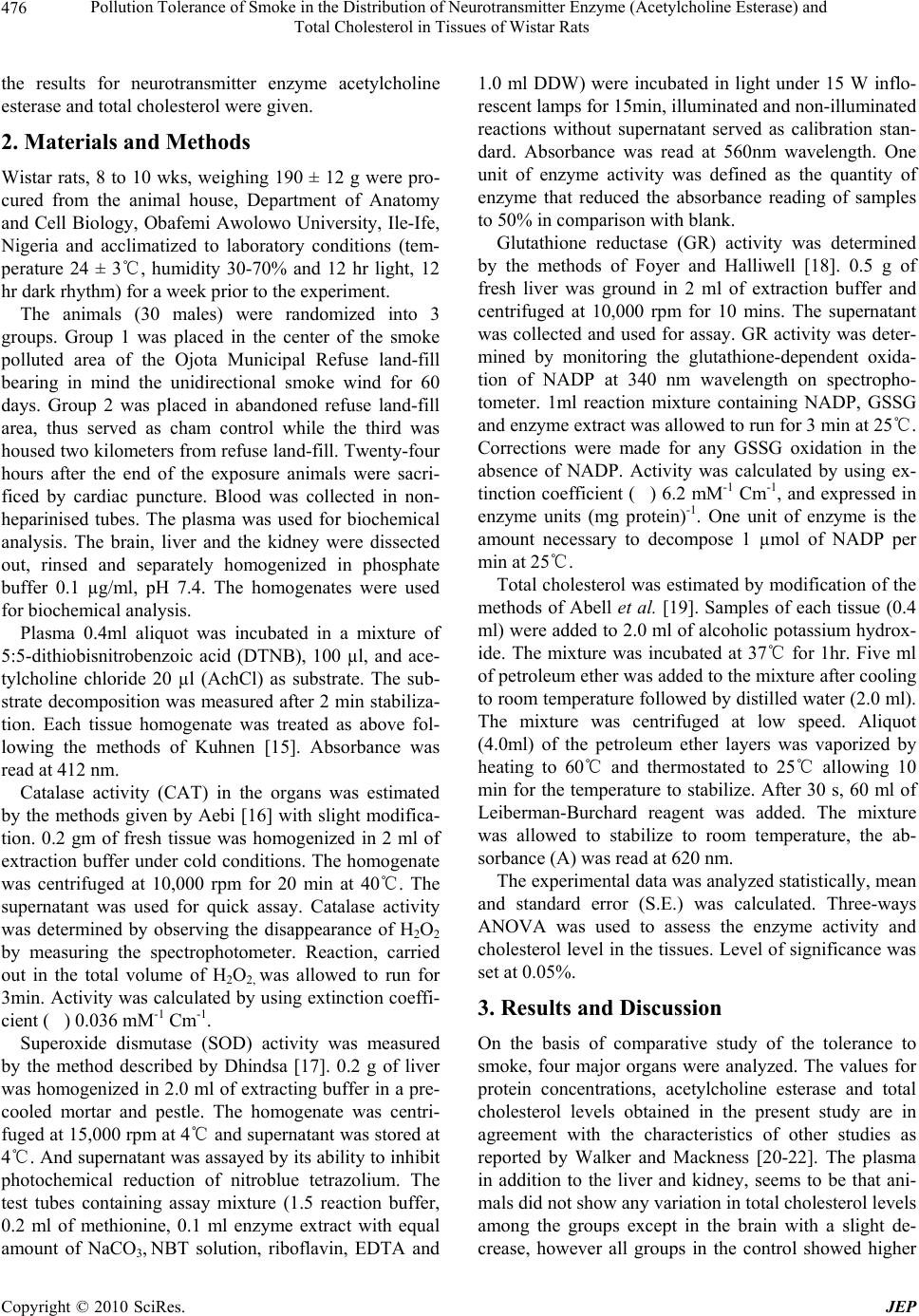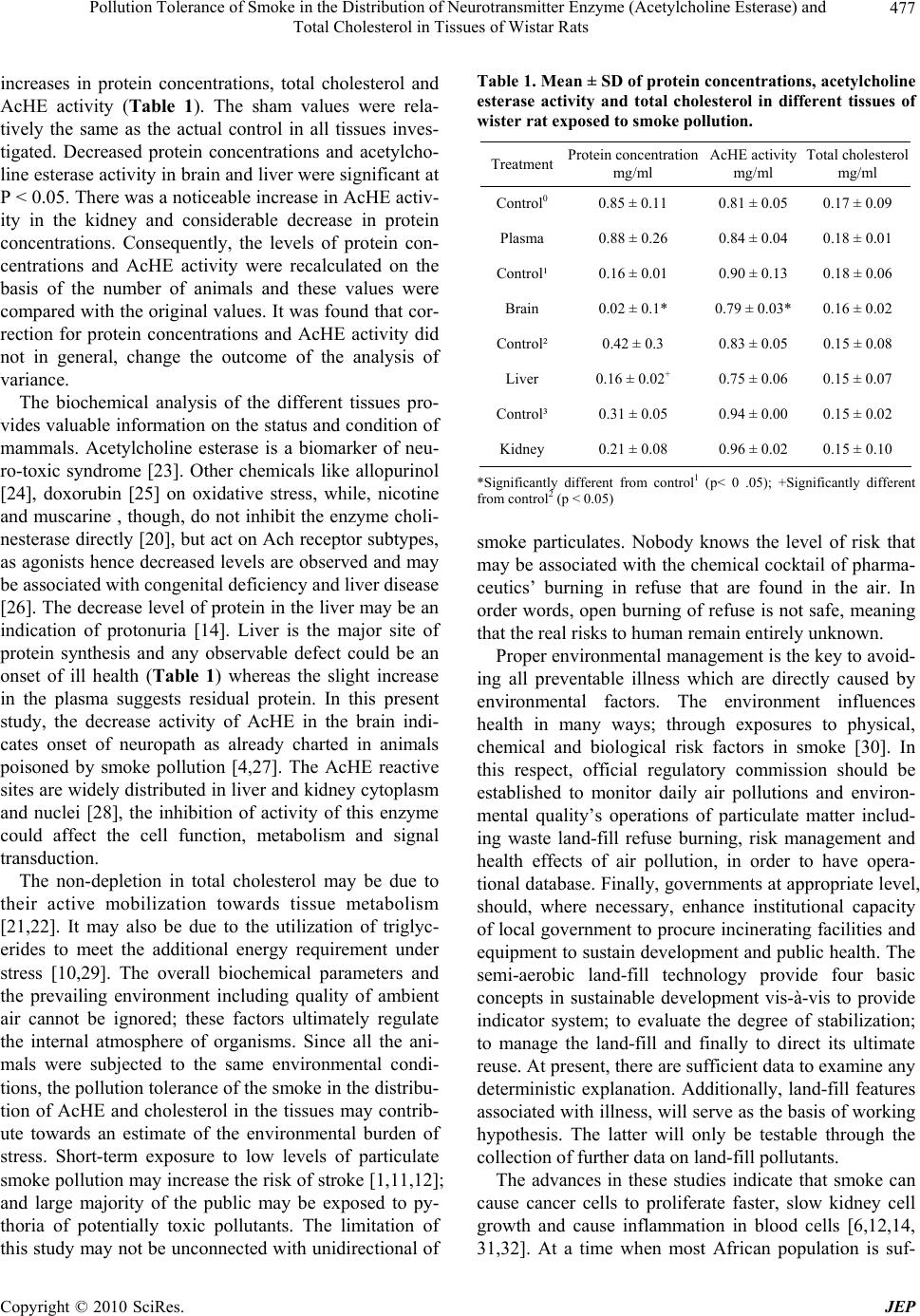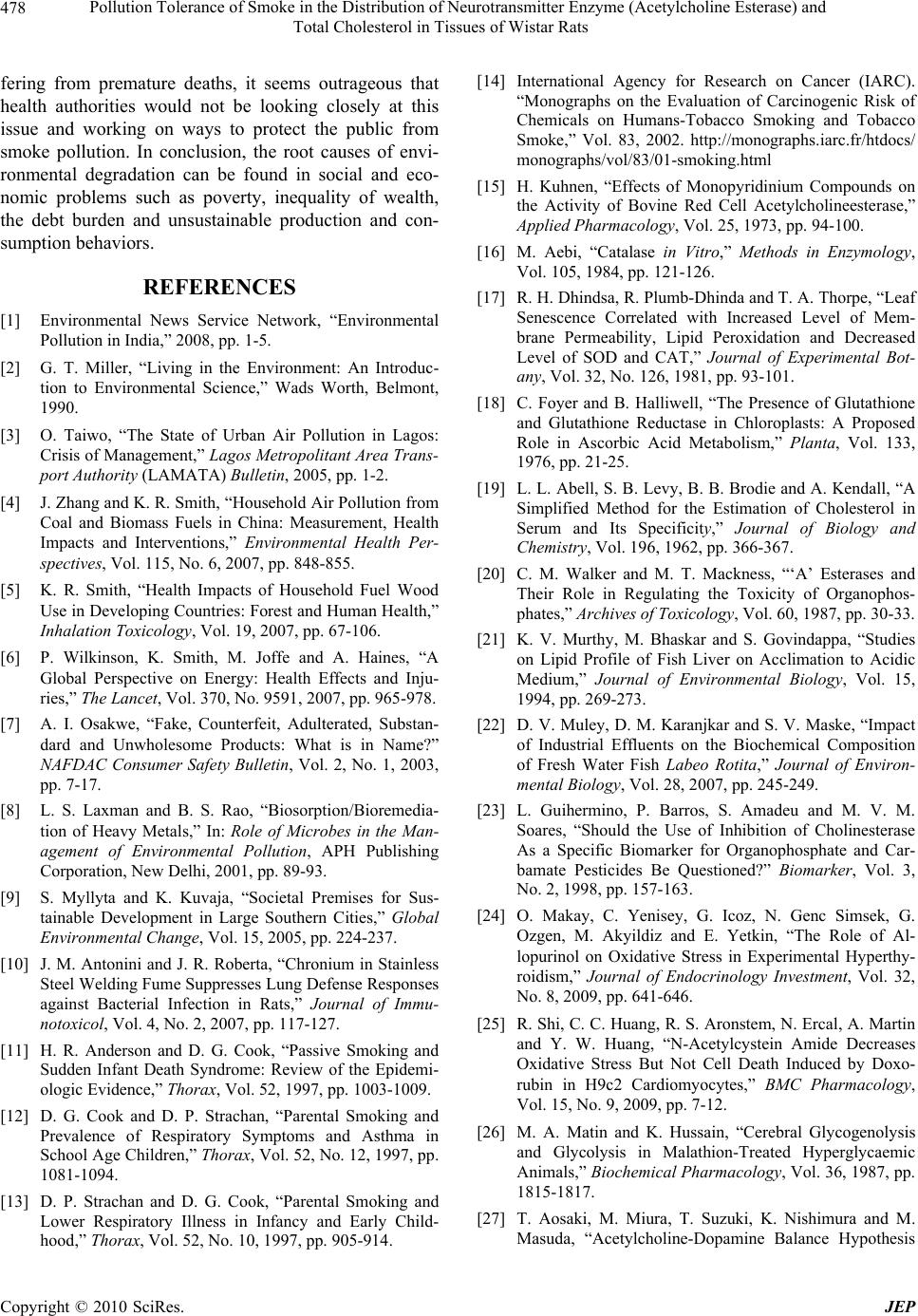Paper Menu >>
Journal Menu >>
 Journal of Environmental Protection, 2010, 1, 475-479 doi:10.4236/jep.2010.14055 Published Online December 2010 (http://www.SciRP.org/journal/jep) Copyright © 2010 SciRes. JEP 475 Pollution Tolerance of Smoke in the Distribution of Neurotransmitter Enzyme (Acetylcholine Esterase) and Total Cholesterol in Tissues of Wistar Rats Albert C. Achudume, Funso Aina, Bill Onibere Obafemi Awolowo University, Il-eIfe Institute of Ecology and Environmental Studies, Ile-Ife, Nigeria. Email: aachudum@yahoo.com Received June 19th, 2010; revised August 16th, 2010; accepted August 20th, 2010. ABSTRACT This study was designed to assess total animal exposure to non-occupational but environmentally induced smoke through short-term landfill burning toxicity tests at the biochemical levels. Exposure to municipal land-fill burning us- ing rat model focused primarily on inhalation exposure. The environmental monitoring consisted of 60 days exposure to refuse burning by evaluating the level of protein concentrations, neurotransmitter enzyme acetylcholine esterase (AcHE), and total cholesterol in different tissues of Wistar rats. Protein concentrations tended to decrease in the brain, liver and kidney and slightly increased in the plasma while acetylcholine esterase decreased in brain and liver and in- creased in the kidney. The non-depletion in total cholesterol levels in the tissues tended to be due to active mobilization towards tissue metabolism. The data were sufficient to support risk assessment for human. Keywords: Municipal Land-Fill, Smoke Pollutants, Acetylcholine Esterase, Total Cholesterol 1. Introduction The ever increasing population due to rapid industrializa- tion and technological advancements, traffic congestion resulting from increase in motor vehicles and urbaniza- tion contribute to a large extent toxic smoke pollution [1]. The degree of intensity and composition of the pollutants vary depending on the level of economic development and industrialization [2]. Owing to frequent power out- ages experience in Nigeria, a number of households and commercial establishments use electric generators. The smoke releases from these generators change the atmos- pheric composition of air in the immediate environment and affect the wellbeing of residents [3,4]. Again, the dependency of indigenes on use of charcoal pot and sawdust packed stove as energy source are major causes of indoor/outdoor smoke pollution [5,6]. Inadequate technology still permits waste refuse to be dumped in land-fills. Some people here-in referred to as “Human scavengers” manually sort for various reposi- tory materials. During sorting in the mid of smoke, scavengers prowl for assorted goods and many more squat in the vicinity. Waste refuse in land-fill may con- sist of inorganic and organic matters and other toxic sub- stances such as disposed asbestos, fabrics and pharma- ceutical products. Urban dumping most times contains surprisingly high particulate matter (PM). What is more, National Agency for Food and Drug Administration and Control (NAFDAC) burned sizeable drugs in open air [7]. The byproducts of various noxious chemicals including heavy metals pose a serious threat to the environment, animals and humans in the surrounding areas [8]. Exposures to particulate matters have long been known as a serious health threat [9]. New information suggests that pollutants in smoke are more toxic than previously thought [6,10]. Particle pollution is a silent killer [3,11]. Short-term exposure to low levels of particulates smoke pollution may increase the risk of stroke or mini-stroke symptoms [12] and acute chronic bronchitis [13] and heart disease [14]. Evaluating such working environment is essential. It is generally required to identify hazards that are present and implement controls such as presorting of hazardous ma- terials, use of personal protective devices and more ef- fective control of burning refuse. The likelihood of ex- posure to decomposition products may affect the basal biochemical mechanisms that may ultimately cause nu- merous public health problems. In the present study, only  Pollution Tolerance of Smoke in the Distribution of Neurotransmitter Enzyme (Acetylcholine Esterase) and Total Cholesterol in Tissues of Wistar Rats Copyright © 2010 SciRes. JEP 476 the results for neurotransmitter enzyme acetylcholine esterase and total cholesterol were given. 2. Materials and Methods Wistar rats, 8 to 10 wks, weighing 190 ± 12 g were pro- cured from the animal house, Department of Anatomy and Cell Biology, Obafemi Awolowo University, Ile-Ife, Nigeria and acclimatized to laboratory conditions (tem- perature 24 ± 3℃, humidity 30-70% and 12 hr light, 12 hr dark rhythm) for a week prior to the experiment. The animals (30 males) were randomized into 3 groups. Group 1 was placed in the center of the smoke polluted area of the Ojota Municipal Refuse land-fill bearing in mind the unidirectional smoke wind for 60 days. Group 2 was placed in abandoned refuse land-fill area, thus served as cham control while the third was housed two kilometers from refuse land-fill. Twenty-four hours after the end of the exposure animals were sacri- ficed by cardiac puncture. Blood was collected in non- heparinised tubes. The plasma was used for biochemical analysis. The brain, liver and the kidney were dissected out, rinsed and separately homogenized in phosphate buffer 0.1 µg/ml, pH 7.4. The homogenates were used for biochemical analysis. Plasma 0.4ml aliquot was incubated in a mixture of 5:5-dithiobisnitrobenzoic acid (DTNB), 100 µl, and ace- tylcholine chloride 20 µl (AchCl) as substrate. The sub- strate decomposition was measured after 2 min stabiliza- tion. Each tissue homogenate was treated as above fol- lowing the methods of Kuhnen [15]. Absorbance was read at 412 nm. Catalase activity (CAT) in the organs was estimated by the methods given by Aebi [16] with slight modifica- tion. 0.2 gm of fresh tissue was homogenized in 2 ml of extraction buffer under cold conditions. The homogenate was centrifuged at 10,000 rpm for 20 min at 40℃. The supernatant was used for quick assay. Catalase activity was determined by observing the disappearance of H2O2 by measuring the spectrophotometer. Reaction, carried out in the total volume of H2O2, was allowed to run for 3min. Activity was calculated by using extinction coeffi- cient () 0.036 mM-1 Cm-1. Superoxide dismutase (SOD) activity was measured by the method described by Dhindsa [17]. 0.2 g of liver was homogenized in 2.0 ml of extracting buffer in a pre- cooled mortar and pestle. The homogenate was centri- fuged at 15,000 rpm at 4℃ and supernatant was stored at 4℃. And supernatant was assayed by its ability to inhibit photochemical reduction of nitroblue tetrazolium. The test tubes containing assay mixture (1.5 reaction buffer, 0.2 ml of methionine, 0.1 ml enzyme extract with equal amount of NaCO3, NBT solution, riboflavin, EDTA and 1.0 ml DDW) were incubated in light under 15 W inflo- rescent lamps for 15min, illuminated and non-illuminated reactions without supernatant served as calibration stan- dard. Absorbance was read at 560nm wavelength. One unit of enzyme activity was defined as the quantity of enzyme that reduced the absorbance reading of samples to 50% in comparison with blank. Glutathione reductase (GR) activity was determined by the methods of Foyer and Halliwell [18]. 0.5 g of fresh liver was ground in 2 ml of extraction buffer and centrifuged at 10,000 rpm for 10 mins. The supernatant was collected and used for assay. GR activity was deter- mined by monitoring the glutathione-dependent oxida- tion of NADP at 340 nm wavelength on spectropho- tometer. 1ml reaction mixture containing NADP, GSSG and enzyme extract was allowed to run for 3 min at 25℃. Corrections were made for any GSSG oxidation in the absence of NADP. Activity was calculated by using ex- tinction coefficient () 6.2 mM-1 Cm-1, and expressed in enzyme units (mg protein)-1. One unit of enzyme is the amount necessary to decompose 1 µmol of NADP per min at 25℃. Total cholesterol was estimated by modification of the methods of Abell et al. [19]. Samples of each tissue (0.4 ml) were added to 2.0 ml of alcoholic potassium hydrox- ide. The mixture was incubated at 37℃ for 1hr. Five ml of petroleum ether was added to the mixture after cooling to room temperature followed by distilled water (2.0 ml). The mixture was centrifuged at low speed. Aliquot (4.0ml) of the petroleum ether layers was vaporized by heating to 60℃ and thermostated to 25℃ allowing 10 min for the temperature to stabilize. After 30 s, 60 ml of Leiberman-Burchard reagent was added. The mixture was allowed to stabilize to room temperature, the ab- sorbance (A) was read at 620 nm. The experimental data was analyzed statistically, mean and standard error (S.E.) was calculated. Three-ways ANOVA was used to assess the enzyme activity and cholesterol level in the tissues. Level of significance was set at 0.05%. 3. Results and Discussion On the basis of comparative study of the tolerance to smoke, four major organs were analyzed. The values for protein concentrations, acetylcholine esterase and total cholesterol levels obtained in the present study are in agreement with the characteristics of other studies as reported by Walker and Mackness [20-22]. The plasma in addition to the liver and kidney, seems to be that ani- mals did not show any variation in total cholesterol levels among the groups except in the brain with a slight de- crease, however all groups in the control showed higher  Pollution Tolerance of Smoke in the Distribution of Neurotransmitter Enzyme (Acetylcholine Esterase) and Total Cholesterol in Tissues of Wistar Rats Copyright © 2010 SciRes. JEP 477 increases in protein concentrations, total cholesterol and AcHE activity (Table 1). The sham values were rela- tively the same as the actual control in all tissues inves- tigated. Decreased protein concentrations and acetylcho- line esterase activity in brain and liver were significant at P < 0.05. There was a noticeable increase in AcHE activ- ity in the kidney and considerable decrease in protein concentrations. Consequently, the levels of protein con- centrations and AcHE activity were recalculated on the basis of the number of animals and these values were compared with the original values. It was found that cor- rection for protein concentrations and AcHE activity did not in general, change the outcome of the analysis of variance. The biochemical analysis of the different tissues pro- vides valuable information on the status and condition of mammals. Acetylcholine esterase is a biomarker of neu- ro-toxic syndrome [23]. Other chemicals like allopurinol [24], doxorubin [25] on oxidative stress, while, nicotine and muscarine , though, do not inhibit the enzyme choli- nesterase directly [20], but act on Ach receptor subtypes, as agonists hence decreased levels are observed and may be associated with congenital deficiency and liver disease [26]. The decrease level of protein in the liver may be an indication of protonuria [14]. Liver is the major site of protein synthesis and any observable defect could be an onset of ill health (Table 1) whereas the slight increase in the plasma suggests residual protein. In this present study, the decrease activity of AcHE in the brain indi- cates onset of neuropath as already charted in animals poisoned by smoke pollution [4,27]. The AcHE reactive sites are widely distributed in liver and kidney cytoplasm and nuclei [28], the inhibition of activity of this enzyme could affect the cell function, metabolism and signal transduction. The non-depletion in total cholesterol may be due to their active mobilization towards tissue metabolism [21,22]. It may also be due to the utilization of triglyc- erides to meet the additional energy requirement under stress [10,29]. The overall biochemical parameters and the prevailing environment including quality of ambient air cannot be ignored; these factors ultimately regulate the internal atmosphere of organisms. Since all the ani- mals were subjected to the same environmental condi- tions, the pollution tolerance of the smoke in the distribu- tion of AcHE and cholesterol in the tissues may contrib- ute towards an estimate of the environmental burden of stress. Short-term exposure to low levels of particulate smoke pollution may increase the risk of stroke [1,11,12]; and large majority of the public may be exposed to py- thoria of potentially toxic pollutants. The limitation of this study may not be unconnected with unidirectional of Table 1. Mean ± SD of protein concentrations, acetylcholine esterase activity and total cholesterol in different tissues of wister rat exposed to smoke pollution. Treatment Protein concentration mg/ml AcHE activity mg/ml Total cholesterol mg/ml Control0 0.85 ± 0.11 0.81 ± 0.05 0.17 ± 0.09 Plasma 0.88 ± 0.26 0.84 ± 0.04 0.18 ± 0.01 Control¹ 0.16 ± 0.01 0.90 ± 0.13 0.18 ± 0.06 Brain 0.02 ± 0.1* 0.79 ± 0.03* 0.16 ± 0.02 Control² 0.42 ± 0.3 0.83 ± 0.05 0.15 ± 0.08 Liver 0.16 ± 0.02+ 0.75 ± 0.06 0.15 ± 0.07 Control³ 0.31 ± 0.05 0.94 ± 0.00 0.15 ± 0.02 Kidney 0.21 ± 0.08 0.96 ± 0.02 0.15 ± 0.10 *Significantly different from control1 (p< 0 .05); +Significantly different from control2 (p < 0.05) smoke particulates. Nobody knows the level of risk that may be associated with the chemical cocktail of pharma- ceutics’ burning in refuse that are found in the air. In order words, open burning of refuse is not safe, meaning that the real risks to human remain entirely unknown. Proper environmental management is the key to avoid- ing all preventable illness which are directly caused by environmental factors. The environment influences health in many ways; through exposures to physical, chemical and biological risk factors in smoke [30]. In this respect, official regulatory commission should be established to monitor daily air pollutions and environ- mental quality’s operations of particulate matter includ- ing waste land-fill refuse burning, risk management and health effects of air pollution, in order to have opera- tional database. Finally, governments at appropriate level, should, where necessary, enhance institutional capacity of local government to procure incinerating facilities and equipment to sustain development and public health. The semi-aerobic land-fill technology provide four basic concepts in sustainable development vis-à-vis to provide indicator system; to evaluate the degree of stabilization; to manage the land-fill and finally to direct its ultimate reuse. At present, there are sufficient data to examine any deterministic explanation. Additionally, land-fill features associated with illness, will serve as the basis of working hypothesis. The latter will only be testable through the collection of further data on land-fill pollutants. The advances in these studies indicate that smoke can cause cancer cells to proliferate faster, slow kidney cell growth and cause inflammation in blood cells [6,12,14, 31,32]. At a time when most African population is suf-  Pollution Tolerance of Smoke in the Distribution of Neurotransmitter Enzyme (Acetylcholine Esterase) and Total Cholesterol in Tissues of Wistar Rats Copyright © 2010 SciRes. JEP 478 fering from premature deaths, it seems outrageous that health authorities would not be looking closely at this issue and working on ways to protect the public from smoke pollution. In conclusion, the root causes of envi- ronmental degradation can be found in social and eco- nomic problems such as poverty, inequality of wealth, the debt burden and unsustainable production and con- sumption behaviors. REFERENCES [1] Environmental News Service Network, “Environmental Pollution in India,” 2008, pp. 1-5. [2] G. T. Miller, “Living in the Environment: An Introduc- tion to Environmental Science,” Wads Worth, Belmont, 1990. [3] O. Taiwo, “The State of Urban Air Pollution in Lagos: Crisis of Management,” Lagos Metropolitant Area Trans- port Authority (LAMATA) Bulletin, 2005, pp. 1-2. [4] J. Zhang and K. R. Smith, “Household Air Pollution from Coal and Biomass Fuels in China: Measurement, Health Impacts and Interventions,” Environmental Health Per- spectives, Vol. 115, No. 6, 2007, pp. 848-855. [5] K. R. Smith, “Health Impacts of Household Fuel Wood Use in Developing Countries: Forest and Human Health,” Inhalation Toxicology, Vol. 19, 2007, pp. 67-106. [6] P. Wilkinson, K. Smith, M. Joffe and A. Haines, “A Global Perspective on Energy: Health Effects and Inju- ries,” The Lancet, Vol. 370, No. 9591, 2007, pp. 965-978. [7] A. I. Osakwe, “Fake, Counterfeit, Adulterated, Substan- dard and Unwholesome Products: What is in Name?” NAFDAC Consumer Safety Bulletin, Vol. 2, No. 1, 2003, pp. 7-17. [8] L. S. Laxman and B. S. Rao, “Biosorption/Bioremedia- tion of Heavy Metals,” In: Role of Microbes in the Man- agement of Environmental Pollution, APH Publishing Corporation, New Delhi, 2001, pp. 89-93. [9] S. Myllyta and K. Kuvaja, “Societal Premises for Sus- tainable Development in Large Southern Cities,” Global Environmental Change, Vol. 15, 2005, pp. 224-237. [10] J. M. Antonini and J. R. Roberta, “Chronium in Stainless Steel Welding Fume Suppresses Lung Defense Responses against Bacterial Infection in Rats,” Journal of Immu- notoxicol, Vol. 4, No. 2, 2007, pp. 117-127. [11] H. R. Anderson and D. G. Cook, “Passive Smoking and Sudden Infant Death Syndrome: Review of the Epidemi- ologic Evidence,” Thorax, Vol. 52, 1997, pp. 1003-1009. [12] D. G. Cook and D. P. Strachan, “Parental Smoking and Prevalence of Respiratory Symptoms and Asthma in School Age Children,” Thorax, Vol. 52, No. 12, 1997, pp. 1081-1094. [13] D. P. Strachan and D. G. Cook, “Parental Smoking and Lower Respiratory Illness in Infancy and Early Child- hood,” Thorax, Vol. 52, No. 10, 1997, pp. 905-914. [14] International Agency for Research on Cancer (IARC). “Monographs on the Evaluation of Carcinogenic Risk of Chemicals on Humans-Tobacco Smoking and Tobacco Smoke,” Vol. 83, 2002. http://monographs.iarc.fr/htdocs/ monographs/vol/83/01-smoking.html [15] H. Kuhnen, “Effects of Monopyridinium Compounds on the Activity of Bovine Red Cell Acetylcholineesterase,” Applied Pharmacology, Vol. 25, 1973, pp. 94-100. [16] M. Aebi, “Catalase in Vitro,” Methods in Enzymology, Vol. 105, 1984, pp. 121-126. [17] R. H. Dhindsa, R. Plumb-Dhinda and T. A. Thorpe, “Leaf Senescence Correlated with Increased Level of Mem- brane Permeability, Lipid Peroxidation and Decreased Level of SOD and CAT,” Journal of Experimental Bot- any, Vol. 32, No. 126, 1981, pp. 93-101. [18] C. Foyer and B. Halliwell, “The Presence of Glutathione and Glutathione Reductase in Chloroplasts: A Proposed Role in Ascorbic Acid Metabolism,” Planta, Vol. 133, 1976, pp. 21-25. [19] L. L. Abell, S. B. Levy, B. B. Brodie and A. Kendall, “A Simplified Method for the Estimation of Cholesterol in Serum and Its Specificity,” Journal of Biology and Chemistry, Vol. 196, 1962, pp. 366-367. [20] C. M. Walker and M. T. Mackness, “‘A’ Esterases and Their Role in Regulating the Toxicity of Organophos- phates,” Archives of Toxicology, Vol. 60, 1987, pp. 30-33. [21] K. V. Murthy, M. Bhaskar and S. Govindappa, “Studies on Lipid Profile of Fish Liver on Acclimation to Acidic Medium,” Journal of Environmental Biology, Vol. 15, 1994, pp. 269-273. [22] D. V. Muley, D. M. Karanjkar and S. V. Maske, “Impact of Industrial Effluents on the Biochemical Composition of Fresh Water Fish Labeo Rotita,” Journal of Environ- mental Biology, Vol. 28, 2007, pp. 245-249. [23] L. Guihermino, P. Barros, S. Amadeu and M. V. M. Soares, “Should the Use of Inhibition of Cholinesterase As a Specific Biomarker for Organophosphate and Car- bamate Pesticides Be Questioned?” Biomarker, Vol. 3, No. 2, 1998, pp. 157-163. [24] O. Makay, C. Yenisey, G. Icoz, N. Genc Simsek, G. Ozgen, M. Akyildiz and E. Yetkin, “The Role of Al- lopurinol on Oxidative Stress in Experimental Hyperthy- roidism,” Journal of Endocrinology Investment, Vol. 32, No. 8, 2009, pp. 641-646. [25] R. Shi, C. C. Huang, R. S. Aronstem, N. Ercal, A. Martin and Y. W. Huang, “N-Acetylcystein Amide Decreases Oxidative Stress But Not Cell Death Induced by Doxo- rubin in H9c2 Cardiomyocytes,” BMC Pharmacology, Vol. 15, No. 9, 2009, pp. 7-12. [26] M. A. Matin and K. Hussain, “Cerebral Glycogenolysis and Glycolysis in Malathion-Treated Hyperglycaemic Animals,” Biochemical Pharmacology, Vol. 36, 1987, pp. 1815-1817. [27] T. Aosaki, M. Miura, T. Suzuki, K. Nishimura and M. Masuda, “Acetylcholine-Dopamine Balance Hypothesis  Pollution Tolerance of Smoke in the Distribution of Neurotransmitter Enzyme (Acetylcholine Esterase) and Total Cholesterol in Tissues of Wistar Rats Copyright © 2010 SciRes. JEP 479 in the Striatum: An Update,” Geriatrics and Gerontology International, Vol. 10, 2010, pp. 5148-5157. [28] B. E. Jones, “From Waking to Sleeping: Neuronal and Chemical Substrates,” Trends Pharmacology Science, Vol. 26, No. 11, pp. 578-586. [29] K. S. P. Rao, K. R. S. Rao, I. K. A. Sahib and K. V. R. Rao, “Combined Action of Carbary and Penthoate on Tis- sue Lipid Derivative of Muscle of Channa Punctatus (Bloch),” Ecotoxicology Environmental Safety, Vol. 9, 1985, pp. 107-111. [30] A. C. Achudume, “Environmental Health, Development and Economic Empowerment of Rural Women in Nige- ria,” Environment Development and Sustainability, Vol. 11, No. 2, pp. 459-469. [31] A. K. Hackshaw, M. R. Law and N. J. Wald, “The Ac- cumulated Evidence on Lung Cancer and Environmental Tobacco Smoke,” British Medical Journal, Vol. 315, No. 7114, 1994, pp. 980-988. [32] J. T. Taylor, E. Davis, P. Dabisch, M. Horsmon, K. Mat- son, C. Crouse and R. Mioduszewski, “Acute Toxic Ef- fects of Inhaled Dichlorvus Vapour on Respiratory Me- chanics and Blood Cholinesterase Activity in Guinea Pigs,” Inhalation Toxicology, Vol. 20, 2008, pp. 465-472. |

